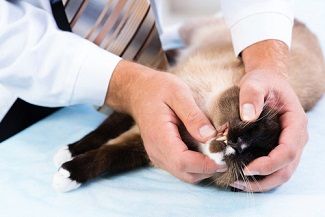Calcium Oxalate Nephrolithiasis in Dogs, Cats, and Humans
The authors of a recent review paper compared idiopathic calcium oxalate (CaOx) nephrolithiasis between dogs, cats, and humans.

As reported in a recent Urolithiasis review paper, a comparison of idiopathic calcium oxalate nephrolithiasis in dogs, cats, and humans has revealed knowledge gaps and suggested the need for an animal model of this disease.
Prevalence and Recurrence
Idiopathic CaOx nephrolithiasis affects dogs, cats, and people, with CaOx stones being the most common type of upper urinary tract stones in these species. Its prevalence in humans has increased, with a more variable prevalence in dogs and cats.
Idiopathic CaOx nephrolithiasis is also recurrent. One human study reported a 10-year recurrence rate of 30% following a person’s first case of CaOx stones. For CaOx bladder stones in veterinary medicine, studies have reported a 3-year recurrence rate of 48% to 57% in dogs and a 2-year recurrence rate of 7% in cats; the authors noted that canine and feline recurrence rates may be underestimated.
RELATED:
- Risk Factors for Chronic Kidney Disease in Cats
- Review of Common Urologic Disorders
Risk Factors
Demography
White non-Hispanic males are at high risk for CaOx nephrolithiasis. Male dogs and cats, particularly neutered males, also have a higher risk. Older dogs (>5—8 years) and cats (10–15 years) and overweight dogs are at risk as well. Several cat breeds (Persians, Himalayans) and dog breeds (Yorkshire terrier, Pomeranian, among others) are predisposed to CaOx stones.
Pathophysiology
Hypercalciuria is the most common pathophysiologic risk factor for CaOx nephrolithiasis in dogs, cats, and humans. In dogs and humans, it is typically idiopathic and associated with normocalcemia; several studies have proposed increased gastrointestinal (GI) calcium absorption as a possible explanation for normocalcemic hypercalciuria. Feline hypercalciuria has not been widely studied.
Dietary calcium restriction is another pathophysiologic risk factor common to all 3 species; such restriction can increase CaOx relative supersaturation. In dogs and cats, dietary sodium restriction also increases the risk for CaOx stones; this contrasts with human studies, which have associated excess dietary sodium intake with increased likelihood of CaOx stone formation.
Hyperoxaluria is important for CaOx nephrolithiasis in humans, but less so for dogs and cats. In humans, hyperoxaluria can be caused by GI disease and excessive dietary oxalate intake. Interestingly, a lack of oxalate-degrading Oxalobacter formigenes in the gut reportedly increases the likelihood of CaOx stone formation in humans and possibly dogs.
Notably, dysfunction of crystallization inhibitors like nephrocalcin could increase the risk for canine CaOx nephrolithiasis.
Other pathophysiologic risk factors, such as hypocitraturia (decreased urinary citrate excretion) and hyperuricosuria (increased urinary uric acid excretion), increase the risk for CaOx stone formation in humans, but have unknown importance in canine and feline CaOx nephrolithiasis.
Renal Pathology
Randall’s plaques, first discovered in the 1930s, are common in humans with idiopathic CaOx nephrolithiasis. Through yet-unknown mechanisms, the plaques first aggregate in renal tubule basement membranes, spread to the interstitium, then breach the renal papillary epithelium. Once exposed to urine, the plaques act as platforms onto which calcium oxalate crystals deposit.
Histopathologic descriptions of CaOx nephrolithiasis in dogs and cats are limited to case reports. One report on feline CaOx nephrolithiasis described parenchymal mineralization next to renal tubules near the renal pelvis, suggesting a feline equivalent of Randall’s plaques. Unfortunately, no reports are available on idiopathic CaOx nephrolithiasis in dogs, underscoring an important knowledge gap.
Looking Forward
A naturally occurring animal model of idiopathic CaOx nephrolithiasis could not only aid in the development of effective prevention and treatment approaches for this disease, but also promote One Health. Although dogs and cats could serve as animal models, the authors emphasized that “further study into the pathology and pathogenesis of this condition is necessary to determine the true potential for dogs and cats to fill this role.”
Dr. Pendergrass received her Doctor of Veterinary Medicine degree from the Virginia-Maryland College of Veterinary Medicine. Following veterinary school, she completed a postdoctoral fellowship at Emory University’s Yerkes National Primate Research Center. Dr. Pendergrass is the founder and owner of JPen Communications, a medical communications company.